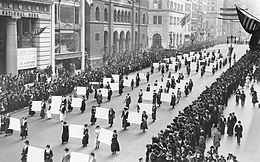 |
| First Lady Florence Mabel (Kling) Harding |
On June 4, 1919, seventy-one years after the drive for women's suffrage had been initiated at Seneca Falls, New York, the U.S. Senate approved a House bill that would amend the Constitution to give women the right to vote. The amendment was then sent to the states for ratification; three-fourths of them had to approve the amendment for it to become law. The bill to amend did not put a time limit on the ratification process, and it took until August 18, 1920 for the ratification requirement to be met. The election of 1920 was the first presidential election in which women voted, and women have been credited (blamed?) for electing Warren G. Harding of Ohio, the affable but highly inept politician whose administration was one of the most corrupt in our nation's history. If women were responsible for putting Harding in the White House, it might have been because his wife, Florence (Kling) Harding, was a supporter of women's suffrage, and more importantly, of equal rights for women. Women might have voted for the power behind the throne, rather than for the throne's occupant.
The National Women's Party, the organization most instrumental in securing passage of the 19th Amendment and its ratification, did not stop its work once the amendment became part of the United States Constitution. Realizing they had an ally in the White House in the person of the First Lady, suffragists advocated for equitable treatment, seeking the repeal of laws that made women second-class citizens, and the passage of laws that guaranteed equal treatment.
 |
| Suffragists' demonstration, New York City, 1917 |
 |
| Jobs Ohio women were prohibited from doing |
 |
Thirteen discriminatory Ohio laws as of 1921. In the margin Dr. Gillette Hayden
noted the numbers of the House and Senate bills introduced to overturn these laws. |
I recently worked on a manuscript collection for the Ohio History Connection that chronicles the suffragist work of Kenyon and Gillette Hayden, Columbus sisters who were prominent in the National Women's Party. Among the papers are lists of restrictions placed on women by Ohio, as well as copies of Ohio House and Senate bills meant to correct the inequity in Ohio's laws. Even for someone who has studied history and knows something about the history of American women's struggle for equality, the ways in which men had legislated against women since Ohio's statehood was sometimes startling, and not a little angering. Despite its history of discriminatory laws, Ohio was one of the first states to ratify the 19th Amendment, doing so on June 16, 1919. The
Times Recorder relegated the news of this important legislative action to page three of its June 17 issue.
As noted above, it was more than an year later before 3/4 of the states ratified the amendment into law. After August 1920, the remaining states took their own sweet time about formally accepting what had become the law of the land: Connecticut, Vermont and Delaware ratified the amendment in 1923; Maryland, 1941, Virginia, 1952; Alabama, 1953; Florida and South Carolina,1969; Georgia, Louisiana and North Carolina, 1971; and Mississippi horsed around until 1984!
 |
| The Times Recorder, June 17, 1919, page 3 |





No comments:
Post a Comment